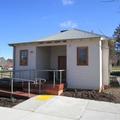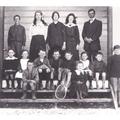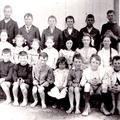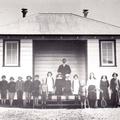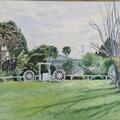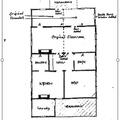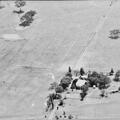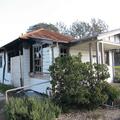< Early Canberra Government Schools
Gungahleen School [1888 - 1923]
Previous Name/s: Stone Hut (1873-1888)
Gunghaleen School began its existence under a different name and a different location. In 1885 the school children and teacher of Stone Hut School moved across the Yass Road to a newly constructed small timber building specifically built as a schoolhouse. The current teacher, Elizabeth Colvin, oversaw the move from Stone Hut into the new building.
There had long been complaints about the condition of the stone building, which was described as a 'dilapidated hovel'. In January 1885, a group of influential local residents including those from the Shumack, Boyd and Mckeahnnie families wrote to the education authorities drawing attention to the conditions at the school. Their complaints brought results. A contract was let to builder, John Kealman, in March 1885 for the erection of a new school building for £125. The building was to be located on land set aside on the opposite (west) side of the Yass Road (Gillespie, 1999).
In August 1885 the move was complete and classes resumed. However, even though in the new timber building the school retained its name as Stone Hut School after its first location. Following a regular visit by school inspector M. Willis, who appeared to see a dilemma in calling a timber school building 'Stone Hut', the name of the school was changed to Gungahleen in 1888. The small school continued to serve the local rural communities as a full-time school (Gillespie 1999).
By 1894 the numbers attending the school began to fall below the threshold determined by the Public Instruction Act and the school began half-time operations in conjunction with Ginninderra School.
In 1915 the original schoolhouse was replaced by a purposely built new timber schoolhouse to accommodate thirty students (NAA A2502).
Despite the new building the student numbers again began to fall and in April 1916 the school closed. However, the closure did not meet with the wishes of the local rural communities. In August the same year Blanch Crace, wife of prominent landholder Everard Gregory Crace of 'Gungahleen', wrote to the Minister for Home Affairs, the Hon. King O'Malley, drawing his attention to the closure of the school which left ten or twelve children without schooling at a most important time of their lives (NAA DSG17/556). The Crace family influence must have hit a chord with O'Malley as he wrote to the Federal Capital Director of Design and Construction asking for full information on the closing of the school (NAA DSG17/556). In September the District Surveyor wrote to the Inspector of Public Schools to advise that, 'the number of children in the district has recently increased owing to closer settlement of the land by tenants of the Commonwealth, and the number now will equal if not exceed the State requirements'. He advised that there were now fourteen or more children 'ready and waiting to attend school and it is, therefore, requested that same be re-opened at as early date as possible (NAA DSG17/556).
Further support came for the opening of the school. In January 1917 the Administrator of the Territory wrote to the Under Secretary, Department of Education guaranteeing attendance of at least twenty-one local children between the ages of five and fifteen years if the school was to reopen. Difficulties in finding an acceptable and qualified teacher followed but in February 1917 the Under Secretary, Department of Education informed the Federal Territory Administrator:
"With reference to your letter dated 18th instant, and previous correspondence, relative to the application for the re-opening of the Provisional School at Gungahleen, I have to inform you that the Department, having considered a report upon the matter, has now decided to re-open the school in question. Action is now being taken with a view to the appointment of a Teacher. I am to add that Mrs. Crace has been informed accordingly". (NAA DSG17/556). A teacher, Laurie Ward, was found who met the approval of the Education Department and the small Gungahleen School was re-opened for the education of the local children.
But despite the influence and concerns of the landed gentry the Gungahleen School again and this time finally had to close its doors in 1923 because of lack of student numbers. On 18 May 1923 the Under Secretary of the Department of Education informed the Home and Territories Department that he had found it necessary to withdraw the present teacher and close the school because of low student numbers. As part of the closing arrangements the Gungahleen students were to be conveyed to Duntroon School at a cost of 30 shillings per week. Temporary funds were allocated to cover these costs (NAA 1923/20728).
The fate of the school was sealed when on 20th July, 1923 the Commonwealth Surveyor General informed:
The [Gungahleen] School was closed some time ago owing to there being insufficient numbers of scholars. These scholars are at present being conveyed to the Duntroon School and in view of the opening of the Telopea School it is extremely unlikely that the [Gunghaleen] School will ever be re-opened. I therefore requested the Works Director to make an estimate for the conversion of this building to a residence.
Mr. Jones, the present master of the Duntroon school is prepared to live there and should at any time it not be required for the residence of a school maser, it would be easily let...
The provision of a residence for the Teacher of the Duntroon School is a matter of urgency and it is therefore recommended that as this would be a suitable residence for the present teacher, that the work be at once put in hand (NAA 1923/20728).
The Duntroon School teacher, David Samuel Jones indicated that he was willing to live in the Gungahleen School if it was converted accordingly. The alternative was to build a house for him at Duntroon. Austerity won the day and the Department of Works converted the empty school house into a dwelling and Mr Jones took up residence. The estimated cost was £525 (NAA 1923/20728).
[authored by Dr Peter Dowling, draft report by Eric Martin & Associates, Canberra, 2012]
In 2014 the school was removed from the ACT Heritage Register after the building had been destroyed by fire, and replaced by a 'replica' building. The history of the school is well summarised in the Heritage Council Background to this decision.
References
Gungahleen School - Reconstructed Gungahleen Schoolhouse / Residence & Site, Conservation & Management Plan, Final, Issue 3, August 2012. Eric Martin & Associates (2012)
ACT Heritage Council. Background Information. Gungahleen School. Feb 2014
Location Map
Related Photos
Teachers
- Nolan, Mary Clare
08/1888 - 03/1891 - Mardardy, Ellen
04/1891 - 09/1892 - Carver, Lauristina
09/1892 - 07/1894 - Hogg, Stuart M.
Half Time, 07/1894 - 02/1895 - Thompson, Mr Charles William
Half Time, 02/1895 - 01/1907 - Ridge, William George Richard
1907 - 1907 - Middleton, Malcolm Sydney
1907 - 1913 - Jackson, Edward Mandeville
1913 - 1915 - Halpin, John
1915 - 1915 - Kemp, George Henry
01/1916 - 04/1916 - Ward, Laurie
02/1917 - 12/1918 - Pryke, Vera
1918 - 1920 - Ball, Mary
1920 - 1921 - Barden, Alice
09/1921 - 05/1923
Related Documents
Heritage assessments / citations:
- National Trust register of significant places. Citation (PDF 182.3 kb)
School building Plans:
- Gungahleen School building plan (PDF 131.5 kb)
NSW Government schools from 1848
- Gungahleen School (external link)
< Early Canberra Government Schools
If you are able to assist our work of identifying, documenting, and celebrating the early bush schools of the Canberra region, please contact us or .


